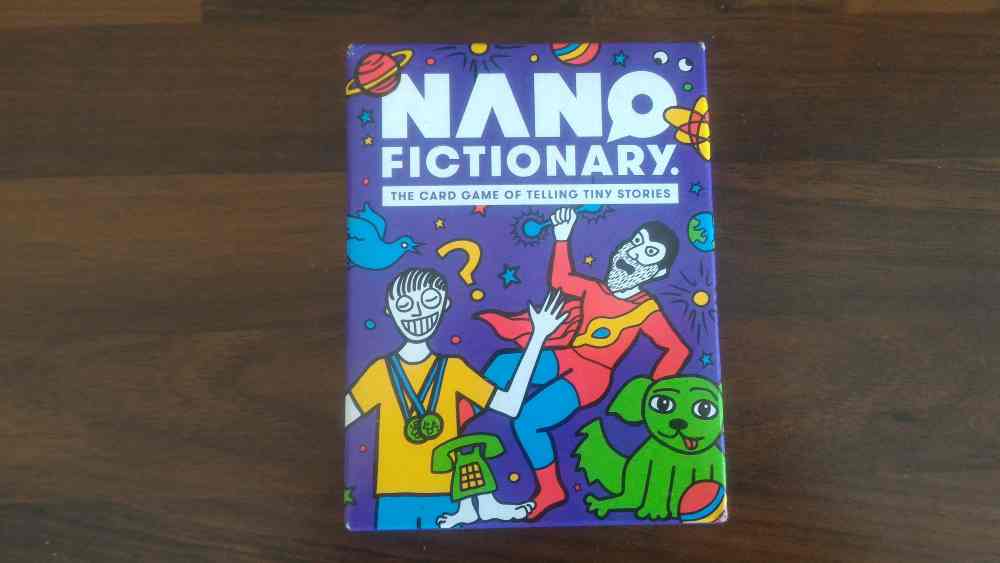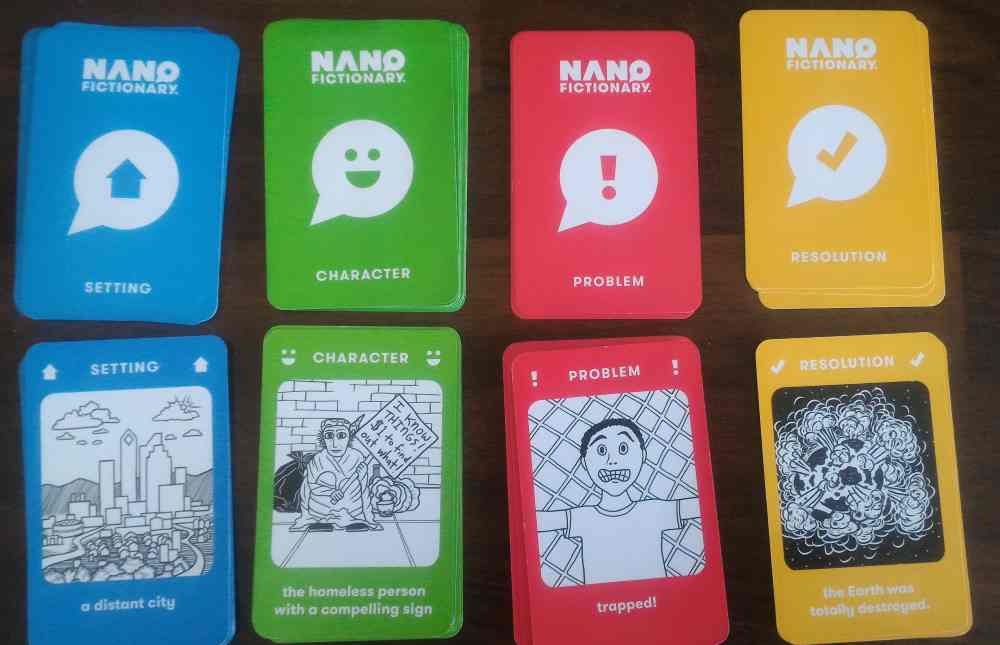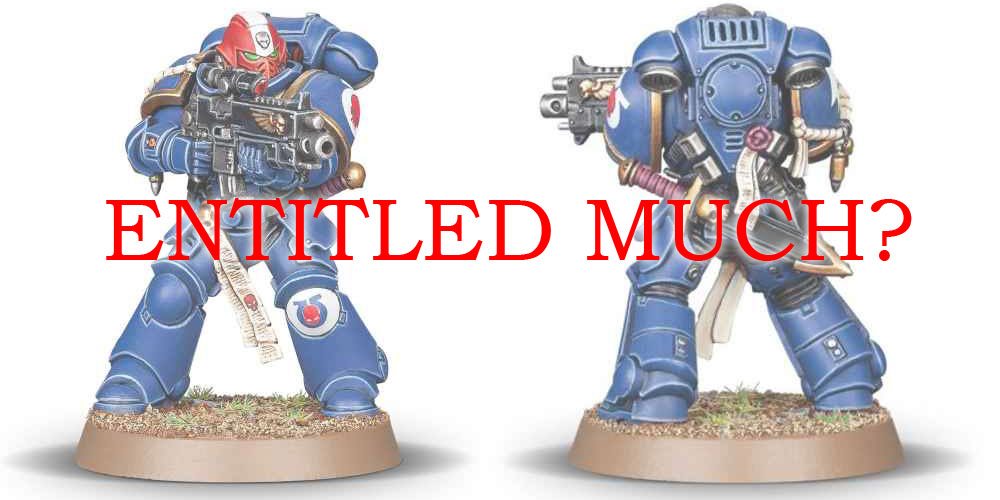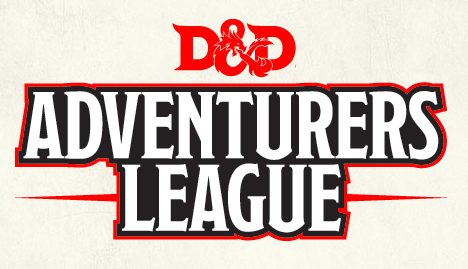
Imagination and storytelling: two cornerstones of childhood and child development. There’s a tendency, I think, for boardgames to focus on the STEM subjects – planning, tactics, and maybe some math. Creating a good game that fires imaginations seems a little trickier. Games perhaps where winning is not quite so important, where the focus is the sheer riotous pleasure of taking part. Here then are three great games to inspire creativity.
Nanofictionary, Randomise, and Space Adventure may come in small boxes but they are huge in terms of interaction. You can put them in your pocket and carry them just about anywhere. They’re 3 portable universes. 3 portals to fun.

What is Nanofictionary?
In short – Rory’s Story Cubes with cards.
Nanofictionary creators Looney Labs have turned small box games into an art form. The brains behind small box behemoth Fluxx (in all its incarnations), they know how to pack an awful lot of fun into a tiny box. Nanofictionary is no exception.
Players (gently) compete for cards to create a hand with which they can tell the best story. Once all players are satisfied with their cards, they take turns to lay them out and regale the rest of the group with their splendiferous tale.
How Do I Play Nanofictionary?
What’s in the box?
- Rules.
- 100 Game Cards in four colors.
What else do you need to play?
- 1-6 players.
- Nothing.

Setup.
- Sort the four types of story element cards into four draw piles. The elements are “Problem” (Red), “Setting” (Blue), “Characters” (Green), and “Resolution” (Yellow).
- Each player receives two Characters, one Setting, one Problem, and one Resolution.
- A discard pile is made for each deck by turning the top card over.
- There are also 6 numbered cards, 1 through 6 which are placed next to the decks, with 1 at the top of the pile and 6 at the bottom.
- Players look at their cards and start to imagine what story they might tell.

Playing the game.
- Start with the player with the shortest name (or however you choose to do it).
- Players take it in turns to draw a card from one of the decks. Alternatively, they can take ANY (but only one) of the cards in the discard pile. After they have picked up a card, players must discard another from their hand.
- The aim of the game is to create a story. The cards have prompts on them, which need to be incorporated, somehow, into the story. These links can be as tenuous or robust as the player desires. A story may contain more than one of any element but must contain at least one of each.
- Once a player is satisfied with their story they lay their cards down and wait for the other players to finish. At this point, they take the first numbered card from the pile. All the other players may take one extra story element, and DON’T have to discard.
- Play then continues until the next person is happy with their story, then they too lay their cards down and pick a number card. Again, all remaining players may take an extra story element. Those who remain in the game longest will end up with the most cards with which to fashion their story.
- Once all players have picked a number card, the first phase of the game ends and players can tell their tales, starting with the person with the number 1 card.
- Once all players have told their stories, players (and anybody else listening) vote to determine which was the best story. In the event of the tie, the person with the lowest number card wins. That’s the pay off for stopping collecting cards first.

And that’s it! Collect up the cards, set up the decks again and deal out fresh elements. Once you’ve had one game of Nanofictionary it’s impossible to stop there.
Should I buy Nanofictionary?
Short answer. “Yes!”
Nanofictionary is a great little game. One that keeps on giving. The text on the cards is open enough to allow as tight or loose and interpretation as a player likes. The stories told evolve as players grow in confidence and explore new, less literal ideas.
There are a couple of issues with the game, but to me, they’re very minor. The scoring system is arbitrary and potentially divisive. You have to vote on the best story, and if you’re playing with grown-ups, and children of varying ages, how do you choose that? In our house the voting stage led to levels of contention that we just didn’t need, so we skipped it. From a parenting point of you, picking which of your children’s stories is best, is like a very mild version of Sophie’s Choice.
The only other issue I had with our games, although it didn’t bother the kids, is card hunting. One of my boys loved the “the world was totally destroyed” card. He’d root through the deck, looking for it until he found it. There is a mechanism in place to stop the last player to put down their story taking too long (they’re only allowed one round after the previous player finished their story,) but if you have two children looking for specific cards you can be sitting doing nothing for a while.
We took Nanofictionary on vacation with us and it came out every night. It’s a really fun way to spend 20 mins, that usually morphed into an hour. My 8 year old loved it and it really brought my 11 year-old’s imagination out into the open. All in all, Nanofictionary is an excellent fun way to spark your children to tell stories.
You can buy Nanofictionary here in the US and here in the UK.

What is Randomise?
In short – Pictionary, crossed with charades, mixed with Who’s in the Bag?
Players draw three cards, each with a word that will convey their new identity. They can choose whether to mime, draw, or describe the things on their cards to the rest of their team. They must do so within the given time limit. Words are chosen randomly from 3 entries on each card. This gives the specific (random) combination of words that describes the player’s new identity. Hilarity ensues.
How do you Play Randomise?
What’s in the box?
- Rules.
- 120 Cards. In three types: A, B, and C.
What else do you need to play?
- At least 4 players.
- Pen and Paper (if you want to draw).
- Stopwatch (sort of optional).
How do you set up a game?
- Divide your group into two teams.
- Create three decks of cards. One for each card type, A, B & C.

How do you play a game?
- Decide which team will go first.
- One person from that team steps up to the “stage” and declares whether they are going to play in easy or hard mode. When playing with children easy mode is almost certainly the way to go. At least at first.
- The player draws one card from each pile, A, B & C.
- Cards have 3 words written on them, numbered 1,2 & 3. There are two sets on each card (easy and hard).
- The opposing team chooses the number for each card that the “actor” must perform. e.g. 2,1,3 or 2,2,2.
- This will give a reasonably ridiculous identity that the “actor” must convey to their teammates. e.g. on easy level, a “Small Teacher Hiding” or a “Funny Sheep Eating Spaghetti.” On hard mode, An “Anxious Pigeon White Water Rafting.” or a “Lively Sailor Doing the Hula.”
- The actor may choose whether to act, describe (verbally), or draw their new identity. It probably goes without saying, that they must do so without using any of the words on the card, but they can break down the description into its component words.
- If you choose describe your identity you have 30 seconds to so; act, 60s, and draw 90s. When playing with children it’s probably best to ditch the timer.
- Scoring: There is one point for every correctly guessed card and a bonus point if your entire identity is guessed within the time limit. In hard mode, you get 3 points for this. It is possible for the opposing team to steal these bonus points if they can guess your identity after your team has failed to do so.
- Games are first to 30 points, or in our case, until bedtime.
- There are a number of alternative ways to play given in the rules sheet.
- There are blank cards included to make your own identities.

Should I buy Randomise?
For $15 why would you not? Randomise is a much sillier game than Nanofictionary and is fun for adults and children alike. It’s hard to imagine pulling out Nanfictionary after the kids have gone to bed, during a family party. It’s easy to conceive games of Randomise continuing long after the small ones have climbed the wooden hills, becoming increasingly more raucous with guesses becoming more and more inspired.
There’s not much to Randomise at all, but it’s huge fun, and massively accessible. It serves up traditional games, that almost everybody has played, in a fresh and interesting way. Randomise slices and dices traditional party games to serve up its very own smorgasbord of fun.
My kids love this game. It prompts their imaginations and helps them overcome inhibitions. It’s great to watch their confidence grow as games progress. It’s lovely to listen to their joyous laughter as they parse the crazy card combinations. Randomise is a super accessible party game for just about everybody.
You can buy Randomise here in the US and here in the UK.

What is The Space Adventure?
In short – Build Your Own Ridiculous Planet.
The Space Adventure is a small boxed storytelling game from Finnish company, Lupo. It’s subtitled “Your Imagination is Humanity’s Only Hope.” It’s aimed at children 8+ and will probably start to wear thin once they reach the jaded cynical age of 13. It’s a game best suited to a large group, I think, and would be ideal in a classroom or as a club activity for something like Cub Scouts. It needs an enthusiastic “Ambassador” to run the game and keep those creative juices flowing.
The premise of the game is that world has been turned into a raisin (a concept hilarious to my middle son) and that players have to find a new home for humanity. Players work together with pen and paper, to design a rocket, discover a planet and create a new settlement there. They will have to befriend new races and overcome unexpected problems along the way.
How do you play The Space Adventure?
What’s in the box?
- Rules.
- 120 Cards.
- 16 World Cards.
- 16 Species Cards.
- 16 Style Cards.
- 16 World Impact Cards.
- 6 Crew Impact Cards.
- 5X5 Role Cards.
- 5X5 Role Mission Cards.
What else do you need to play?
- 3-25 players + 1 Ambassador (who, in more common geek game parlance is effectively the GM).
- Pens and Paper in as many inspiring colors as you can find.
- Post-it notes are very useful.
- Anything else that might help the players tell a story. For example: building your town in Minecraft.
How do you play the game?
The Space Adventure takes place over a series of rounds, each arbitrated and facilitated by the Ambassador over a number of steps.
1: Give the briefing.
- The ambassador explains the situation to the young explorers.

2: Form Space Crew
- Players choose a name for their characters.
- Each player is given a role card. e.g. The Bionaut, “From one Seed you can build a village” or the Protectornaut, “I was born to save everyone.”
- Players introduce themselves and decide a name for their space crew.
3: Build Spaceship
- Players design their ship together, loosely based on what they called themselves.

4: Lift off!
- Each player is given a designated mission for their role.
- Each crew is given a world card.
- Another species arrived at your new world at the same time! Each crew is given a species card that they must interact with.
- Your new civilizations will be grander than anything that has gone before. Give each crew a style card.

5: Town Creation
- The bulk of the game. Crews work together to build their new towns. They need to bear in mind the various aspects of their role cards as they do this.
- Players also need to have fun. The ambassadors are prompted “to keep up the ridiculous mood.”
- Crews can be given additional “world impact cards” if they working too quickly or need a greater challenge. e.g. “Guests Incoming” – Design a new species or “No Parking Space” – Build an intergalactic airport.
- Crews can also be given a crew impact card “to make them do ridiculous things.” e.g. “Limited Oxygen” – No talking for two minutes or “Writing Home” – The homesick crew must write to their family and friends about their mission.

6: Showtime!
- Crews present their creations.
- There is a scoring system on the Lupo website, but this is entirely optional. It doesn’t even come in the game box. Personally, much as with Nanofictionary, awarding a winner is likely to be difficult and divisive. If the font of creativity springs, everybody wins!
Should I Buy The Space Adventure?
The answer to this depends on a couple of things. The Space Adventure is certainly a great storytelling opportunity. It allows creativity in a whole manner of media. Players are limited only by the available resources and their imaginations. It does, however, rely on the ambassador to keep things going. This person has to be the type of person to keep children energized and focused on what they’re doing. The Space Adventure is certainly engaging, so the second part shouldn’t be too tricky.
Whilst you can play in small groups. The game doesn’t lend itself that well to a family game night. 10-15 players of a similar age group, I think would be the optimum number for the game. You could easily have more players in a teaching environment, where there is space and resource for all players to give their input. Much like a real mission into space, The Space Adventure requires some advanced planning to get off the ground.
Certainly, though, the game is a great ice-breaker or team builder for groups of kids, and with a little tweaking could slot nicely into school curriculums. As well as the single box game, Lupo has all sorts of teaching resources. I’m not a teacher, but it’s easy to see The Space Adventure working very well in a classroom. I’d love to get into my kids’ school and run a couple of sessions. I think it would be very rewarding for all concerned.
You can buy Lupo’s The Space Adventure, here in the US and here in the UK.

So which of the three is best?
All three games have their strengths and are invaluable under the right circumstances. Randomise is simple and easily accessible; everybody has seen its elements before. It’s a true family game. Nanofictionary has to get over the hump of “Oh, I can’t play, I’m rubbish at telling stories,” the reply to which is, “No you’re not. Not with this game.” It would work well in a classroom, much like The Space Adventure. Lupo’s game comes into its own with larger groups, with lots of time to explore players’ imaginations.
Whichever you choose you’re in for a treat!
Click here to see all our tabletop game reviews.
If you’d like to stay up-to-date with all of our tabletop gaming coverage, please copy this link and add it to your RSS reader.
Disclosure: GeekDad received a copy of this game for review purposes.



